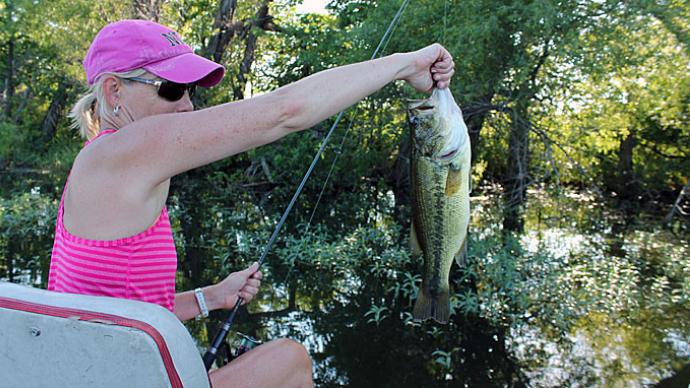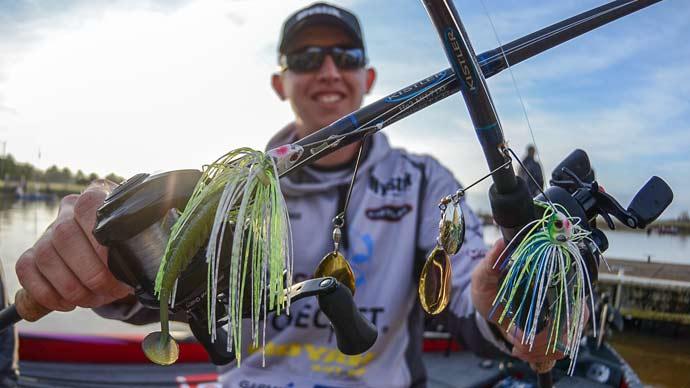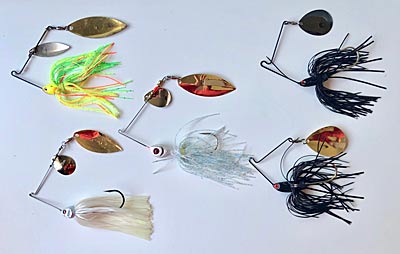
Spinnerbaits can be very confusing, especially when just starting bass fishing. So many types, colors, and sizes of blades; so many colors and shapes and weights; so many different wires used for arms – plus with arms, there are closed bends and open bends. How in the world do you choose one, and more importantly – how do you fish spinnerbaits effectively?
I was at a tackle shop recently when a gorgeous spinnerbait caught my eye. I took the package off the shelf and immediately realized why it appealed to me. It was gold-plated. Not just gold colored – it was plated with 14-carat gold. The price tag? Just shy of $70. I wouldn’t buy that unless I could wear it. It made me remember when I was in a little bait shop near Roosevelt Lake, and there was a carousel of spinnerbaits on the counter, each for just $1.99. Well, who could resist that? I bought a handful, one of which was undoubtedly the ugliest spinnerbait you’ve ever seen – a single Colorado blade and a gaudy dark green and gold tinsel skirt. I don't know what the skirt was, but it looked like tinsel.
The next day was cloudy, so I tied that ugly spinnerbait on and caught smallmouth on it all day. The guy I was fishing with, a pitcher on a pro baseball team, finally sat down and started going through his tackle, looking for a way to make himself a bait that looked like mine. Would that $70 gold-plated lure have worked better than my $2 spinnerbait? I seriously doubt it.
Blades For Beginners
The most important part of a spinnerbait is the blade. Many spinnerbaits have two blades, and sometimes each has a different shape. No matter its shape, a blade is designed to spin in the water and produce flashes of reflected light. Willow leaf blades, those narrow blades pointed at both ends, spin easily and have the least resistance in the water. They flash quite a bit, especially the hammered blades that have many different angles on the surface to catch the light. Double willow leaf blades are just about my favorite, and I like to have the front blade silver and the trailing blade gold. I keep a supply of gold willow leaf blades so I can change the blades if I buy one with two silver blades.
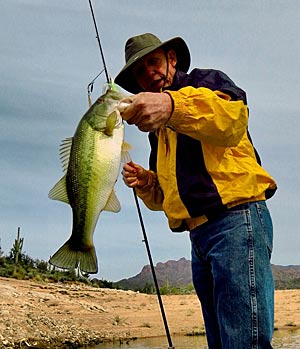
The big, almost round blades are Colorado blades. I usually fish just one blade if it’s a Colorado blade. A deeper cup to the blade will keep it spinning even at slow speeds, so these are great for slow-rolling on the bottom or keeping it at a certain depth. If I’m slow-rolling it, I’ll use a bit heavier bait, so it gets down there quickly and lets me get down to business. I even have some big spinnerbaits with black skirts and red or black Colorado blades. These are my night fishing baits. Those big dark blades show up well silhouetted against the night sky.
The Indiana blade is supposed to be great for moderate speeds between the willow leaf and Colorado. I don’t know precisely what a moderate speed is – I’m fishing a spinnerbait almost as fast as I can or so slow that I’m just barely keeping the blades spinning. I see a lot of Indiana blades as the first blade, with a Colorado or a willow leaf blade behind. Just covering all the bases, I guess. It will thump more than a willow leaf but not have as much resistance as a Colorado. There are other specialty blade shapes, but you won’t see them as often.
The size of the blade affects how deep a lure will run – a bigger blade, especially a big, wide blade, will give more lift to the bait. My slow-rolling baits usually have a big heavy head so that I can keep them down deep despite the big Colorado blade. A light spinnerbait with willow leaf blades is ideal for running under the surface. The heavier the head, the deeper you can get it to run. You can use a lighter spinnerbait with willow leaf blades almost as a topwater lure, reeling to keep it waking just under the surface.
Blade finishes are almost unlimited. Basic colors are silver and gold, but you can get tons of different colors, including blades painted to look like fish. You can also get blades half gold and half silver to cover all the bases. If the sun is out, choose a flashy blade. If the water is dirty, try a fluorescent green or orange, along with a standard gold. Tradition has it that silver is excellent for sunny days and gold for cloudy days. I like dark blades at night and in dirty water. All blades put out a vibration, which is what bass feel with their lateral line. They can home in on your bait just based on that, but once they get close, give them something they can see.
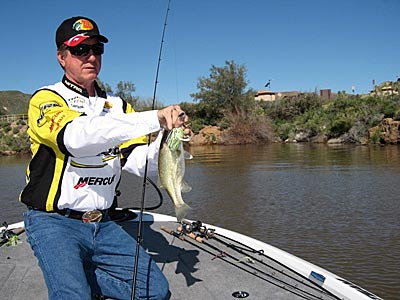
Blade Wires
The wire on a spinnerbait has a bend to tie your line to. The open R-shaped bends give your bait more action, but they can break more easily than the closed eye wires. The wires can be stainless steel, piano wire, titanium, or just about any metal. The bottom line is this: the thinner the wire, the more vibration you can get out of those blades. If you’re fishing in cover, try a spinnerbait where the back wire goes past the hook. Titanium makes such good spinnerbaits because you can get a thin wire and still have strength. A thin wire that breaks easily is worse than a fat wire.
Heads
When you are just starting, it’s a good idea to keep things as simple as possible until you’re comfortable. If you are fishing through cover, choose a bait with a pointed head that can get through. If you’re slow-rolling, pick a bait with a bigger head, maybe one that crash into rocks without getting too beat up. You can tell how a bait will move by looking at the head.
Skirts
Silicone skirts are by far the most popular – they have a lot of action, wear well, and last quite a long time. In fact, on my skirts, it’s almost always the little rubber band that holds it on the bait head that wears out, not the skirt. I always keep a lot of spare skirts in my favorite colors in my tackle bag. Spare skirts enable you to change the bait without even untying it.
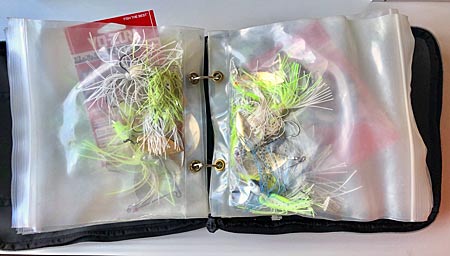
Storage
I keep my spinnerbaits in a soft-sided bag that zippers around three sides and has a bunch of individual zipper bags inside. It’s like a big binder for baits. This lets me see the spinnerbaits quickly – I keep like with like. For instance, one bag may have three or four white 3/8-ounce baits with double willow leaf blades. The next bag might have big baits with a single Colorado blade. One bag has spare parts – skirts, blades, split rings. I can quickly find the bait I want. I’ve tried those boxes you hang in and other boxes, but I like the bag the best.
Nitty Gritty
The best way to learn how to fish a spinnerbait is to do it. Get some essential baits with basic blades and start throwing them. You’ll be amazed at how many fish like them, and after you catch a few, you’ll start to realize what it is that you’re doing right. Nothing beats success. Don’t go too wild with colors and all that at first – stick with the basics like white, chartreuse, or a combination of the two. Out here, we also like blue and white. Try to match the skirt colors to the colors of the baitfish where you’re fishing. I like to cover the bases, so I usually use one silver and one gold blade. Try that, and don’t give up until you start catching fish.
Tips For Fishing Spinnerbaits
(with thanks to Sam Shattenberg)
- Remember that a percentage of fish can always be found within eight to ten feet from shore. Cast as close to the edge as you can.
- Mixing blades look more attractive.
- If you’re not getting bit, try a different color skirt.
- Cast right to the bank and start reeling as soon as the bait hits the water – you need to take up the slack line and get the blades moving.
- Add red to every bait. One of the best spinnerbait fishermen I ever met (Sam Shattenberg) keeps a red marker in his boat and adds red to the blade – a dot about as big as your thumbnail.
- Good fish are usually on something like a little crease or something else you can figure out. For instance, they love cockleburs.
- Point the rod straight at the bait as you fish it, and keep one finger under the line in front of the reel. That lets you feel everything that is going on.
- First thing in the morning, wake a spinnerbait just under the surface next to the bank near cuts.
- Flats with a drop-off are excellent in the morning in cool weather.
- Fish a single blade bait on points with stair-steps down to 18-20 feet deep. Try those four or five times during the day.
- Criss-cross points every which way before moving on.
- As soon as you hit something, stop reeling and pull the spinnerbait by moving the rod up – it changes the action and triggers bites. If you’re struggling, or if you’re slow-rolling, this bump and pull can change everything.
- Keep the line taut.
- Jerk straight up and back while reeling to get a good hookset.
- Use a rod with a heavy action and a sensitive tip.
- A 5.3:1 reel is excellent for spinnerbaits – like those old Garcia reels.
My granddaughter was fishing spinnerbaits successfully at age nine without knowing a thing about them. You can do it too – get out there and do it.


